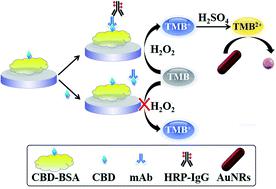当前位置:
X-MOL 学术
›
Anal. Methods
›
论文详情
Our official English website, www.x-mol.net, welcomes your
feedback! (Note: you will need to create a separate account there.)
A multicolor enzyme-linked immunoassay method for visual readout of carbendazim
Analytical Methods ( IF 2.7 ) Pub Date : 2021-08-09 , DOI: 10.1039/d1ay01028j Haoran Liu 1, 2 , Yiwen Wang 1, 2 , Ruijie Fu 1, 2 , Jing Zhou 1, 2 , Yanlin Liu 1, 2 , Qiyang Zhao 1, 2 , Jingjing Yao 3 , Yongliang Cui 1, 2 , Chengqiu Wang 1, 2 , Bining Jiao 1, 2 , Yue He 1, 2
Analytical Methods ( IF 2.7 ) Pub Date : 2021-08-09 , DOI: 10.1039/d1ay01028j Haoran Liu 1, 2 , Yiwen Wang 1, 2 , Ruijie Fu 1, 2 , Jing Zhou 1, 2 , Yanlin Liu 1, 2 , Qiyang Zhao 1, 2 , Jingjing Yao 3 , Yongliang Cui 1, 2 , Chengqiu Wang 1, 2 , Bining Jiao 1, 2 , Yue He 1, 2
Affiliation

|
Enzyme-linked immunosorbent assay (ELISA) with high specificity and sensitivity is one of the most popular techniques for detecting carbendazim (CBD), a commonly used benzimidazole fungicide in agriculture. However, the traditional ELISA based on the horseradish peroxidase (HRP)-3,3′,5,5′-tetramethylbenzidine (TMB) system for CBD only displays the yellow color of TMB2+ from deep to light, making it difficult for the naked eye to judge whether CBD in fruits and vegetables exceeds the maximum residue limit. In this article, we intend to improve the traditional ELISA method to establish a multicolor signal output ELISA to achieve visual semiquantitative detection of CBD. This method is based on the optical properties of gold nanorods (AuNRs). After introducing AuNRs into TMB2+ solution, which was produced by the HRP-TMB system of traditional ELISA, AuNRs were quickly etched by TMB2+. Consequently, the longitudinal localized surface plasmon resonance peak of AuNRs shows a clear blue shift and a vivid color change. Different concentrations of CBD generate different amounts of TMB2+, which in turn leads to different etching degrees of AuNRs, and ultimately results in a rainbow-like color change. As a result, CBD from 0.08 to 100 ng mL−1 can be easily distinguished by the naked eye, which does not require any large instruments. Moreover, the colors displayed by 0.49 ng mL−1 (purple) and 0 ng mL−1 (pink) are significantly different from each other. It should be noted that 0.49 ng mL−1 is far below the most stringent maximum residue limit of CBD in the world. Additionally, the quantitative determination of CBD spiked in canned citrus, citrus fruits, chives, and cabbage samples showed satisfactory recoveries. The good performance of the AuNR-based ELISA makes it have a wide range of application prospects in food safety and international trade.
中文翻译:

一种多菌灵视觉读数的多色酶联免疫分析方法
酶联免疫吸附试验 (ELISA) 具有高特异性和灵敏度,是检测多菌灵 (CBD) 的最流行技术之一,CBD 是一种农业中常用的苯并咪唑杀菌剂。然而,基于辣根过氧化物酶 (HRP)-3,3',5,5'-四甲基联苯胺 (TMB) 系统的传统 ELISA 检测 CBD 仅显示 TMB 2+由深到浅的黄色,难以肉眼判断果蔬中CBD是否超过最大残留限量。本文拟对传统ELISA方法进行改进,建立多色信号输出ELISA,实现CBD的可视化半定量检测。该方法基于金纳米棒 (AuNR) 的光学特性。将 AuNRs 引入 TMB 2+ 后在传统 ELISA 的 HRP-TMB 系统产生的溶液中,AuNRs 被 TMB 2+快速蚀刻。因此,AuNRs 的纵向局域表面等离子体共振峰显示出明显的蓝移和鲜艳的颜色变化。不同浓度的CBD产生不同量的TMB 2+,进而导致AuNRs的蚀刻程度不同,最终导致彩虹般的颜色变化。因此,无需任何大型仪器,肉眼即可轻松区分0.08 至 100 ng mL -1 的CBD 。此外,0.49 ng mL -1(紫色)和0 ng mL -1(粉红色)显示的颜色彼此显着不同。需要注意的是,0.49 ng mL-1远低于世界上最严格的CBD最大残留限量。此外,对柑橘罐头、柑橘类水果、细香葱和卷心菜样品中加标的 CBD 的定量测定显示出令人满意的回收率。基于AuNR的ELISA的良好性能使其在食品安全和国际贸易中具有广泛的应用前景。
更新日期:2021-09-01
中文翻译:

一种多菌灵视觉读数的多色酶联免疫分析方法
酶联免疫吸附试验 (ELISA) 具有高特异性和灵敏度,是检测多菌灵 (CBD) 的最流行技术之一,CBD 是一种农业中常用的苯并咪唑杀菌剂。然而,基于辣根过氧化物酶 (HRP)-3,3',5,5'-四甲基联苯胺 (TMB) 系统的传统 ELISA 检测 CBD 仅显示 TMB 2+由深到浅的黄色,难以肉眼判断果蔬中CBD是否超过最大残留限量。本文拟对传统ELISA方法进行改进,建立多色信号输出ELISA,实现CBD的可视化半定量检测。该方法基于金纳米棒 (AuNR) 的光学特性。将 AuNRs 引入 TMB 2+ 后在传统 ELISA 的 HRP-TMB 系统产生的溶液中,AuNRs 被 TMB 2+快速蚀刻。因此,AuNRs 的纵向局域表面等离子体共振峰显示出明显的蓝移和鲜艳的颜色变化。不同浓度的CBD产生不同量的TMB 2+,进而导致AuNRs的蚀刻程度不同,最终导致彩虹般的颜色变化。因此,无需任何大型仪器,肉眼即可轻松区分0.08 至 100 ng mL -1 的CBD 。此外,0.49 ng mL -1(紫色)和0 ng mL -1(粉红色)显示的颜色彼此显着不同。需要注意的是,0.49 ng mL-1远低于世界上最严格的CBD最大残留限量。此外,对柑橘罐头、柑橘类水果、细香葱和卷心菜样品中加标的 CBD 的定量测定显示出令人满意的回收率。基于AuNR的ELISA的良好性能使其在食品安全和国际贸易中具有广泛的应用前景。











































 京公网安备 11010802027423号
京公网安备 11010802027423号